If you’re looking to enhance the beauty of your garden, consider adding vines to the mix. These versatile plants not only offer stunning white flowers but some of them even provide edible food! We’ve compiled a list of 22 vines that produce exquisite white flowers, along with some useful tips and tricks on how to cultivate them.
Let’s start with the Japanese Climbing Hydrangea, also known as the climbing hydrangea. This charming vine originates from the woodlands of Japan, the Korean peninsula, and Sakhalin Island. While it’s not native to North America, it has become a popular choice among gardeners in the region. With a potential length of 30 to 50 feet and a spread of 5 to 6 feet, this woody climber adds a touch of elegance to any garden. Many people grow it as an ornamental plant, either in garden pots or alongside tall trees. It is also frequently planted beneath fences, utilizing them as a natural support system. If you decide to grow this vine, remember that it thrives in full morning sun and afternoon shade, especially in hotter climates.
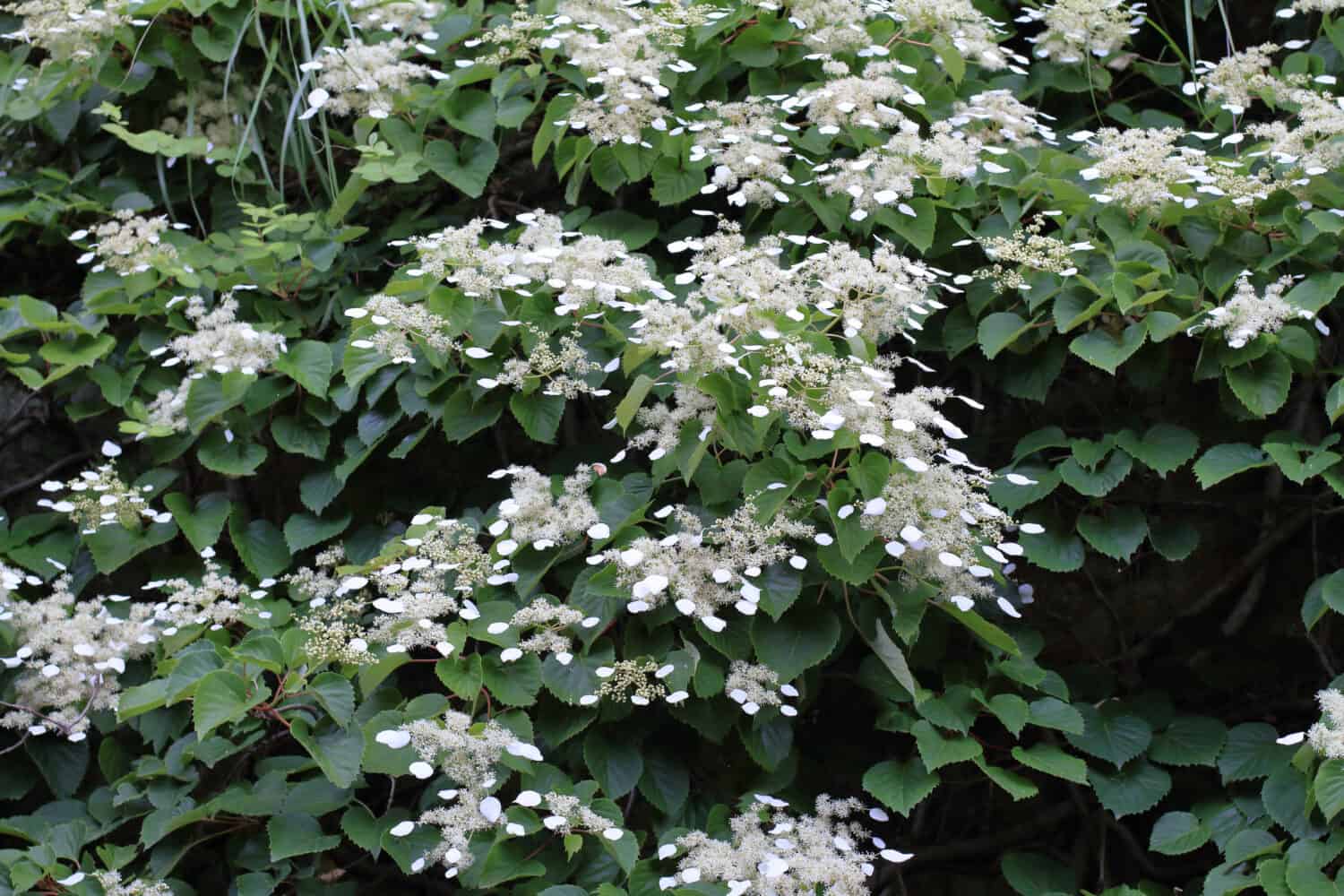
The snake gourd is another vine with beautiful white flowers that can be found in gardens across North America. Unlike the Japanese climbing hydrangea, which is native to Japan, the snake gourd originates from regions in south and southeast Asia such as India, Malaysia, Pakistan, and China. Although it is not originally from Africa, it has become naturalized there as well.
One of the unique features of the snake gourd is its lace-like white flowers that bloom at night. These flowers have long white hairs that curl up, giving them an exotic appearance. Alongside these stunning blooms, the vine also boasts large leaves that can reach up to 10 inches in length.
Aside from its aesthetic appeal, the snake gourd also produces long and delicious vegetables. Often harvested as immature vegetables in Asia, these snake gourds can grow up to an impressive 59 inches in length. As the fruit matures, it undergoes a color transformation, turning from green to red, and developing a slight bitterness.
In conclusion, the snake gourd is an intriguing plant that adds beauty and culinary possibilities to gardens. Its white flowers, unique growth pattern, and versatile vegetable make it a worthwhile addition for gardening enthusiasts.
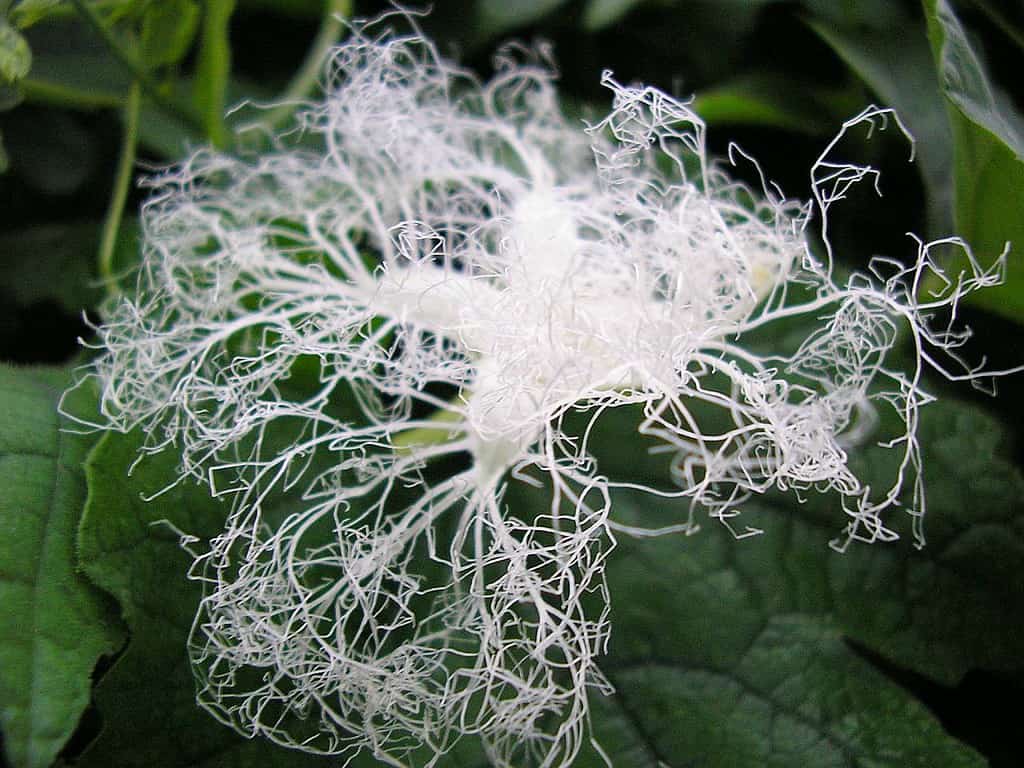
Snake gourds are known for their delicate and intricate white flowers that open during the nighttime.
©tanakawho / CC BY 2.0 – License
3. The Southern Dewberry
A charming vine with white blossoms, the Southern Dewberry belongs to the rose family and is native to regions in North America, including the southern parts of the United States and northern Mexico. While some varieties of the Southern Dewberry grow as shrubs, others take the form of vines. As a shrub, it can grow up to a height of 8 feet, but it can also sprawl and twine along the ground as a vine. In addition to its aesthetic appeal, the Southern Dewberry is renowned for its delectably sweet and tangy fruits, which ripen in the springtime. These fruits are commonly consumed raw or used in the preparation of jams. To cultivate a thriving and robust Southern Dewberry plant, it is advisable to provide deep watering sessions but only when the soil has sufficiently dried out.
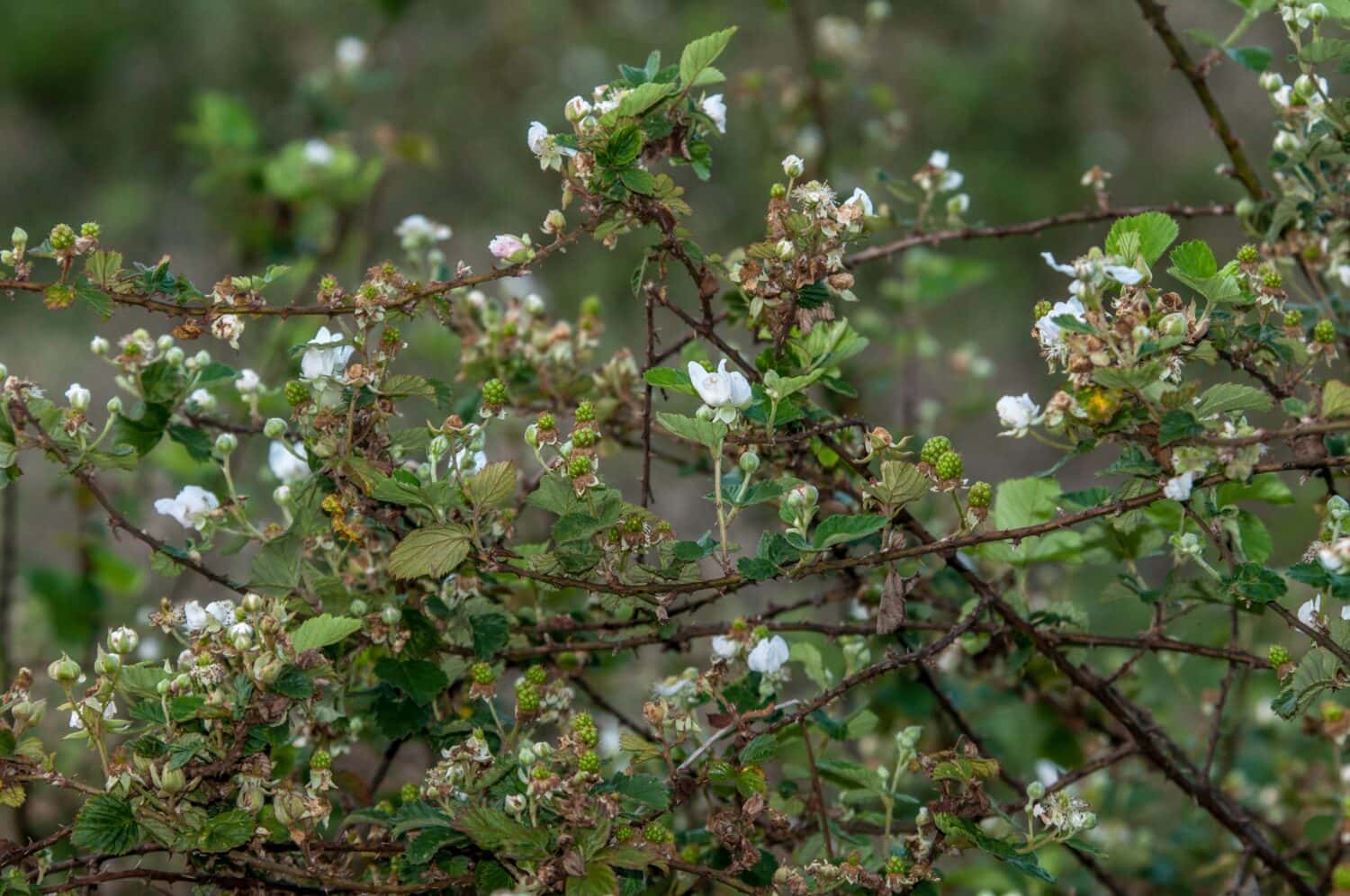
Introducing another vine that showcases stunning white flowers – the southern dewberry. This versatile plant can also grow as a shrub, adding to its allure. The southern dewberry is known for its elegant white blooms that captivate the eye.
Moving on to the white coral vine, also referred to as the queen’s wreath, it is a remarkable addition to any garden. While it is renowned for its white flowers, it is worth noting that these blossoms can also exhibit shades of dark or light pink. Native to the coastal plains of Mexico, particularly the Pacific and Atlantic regions, this vine can be found in abundance throughout the southern United States. Its striking appearance and tall, shady nature make it a popular choice for ornamental purposes. Should you wish to cultivate your own coral vine, consider planting seeds indoors during the spring season.
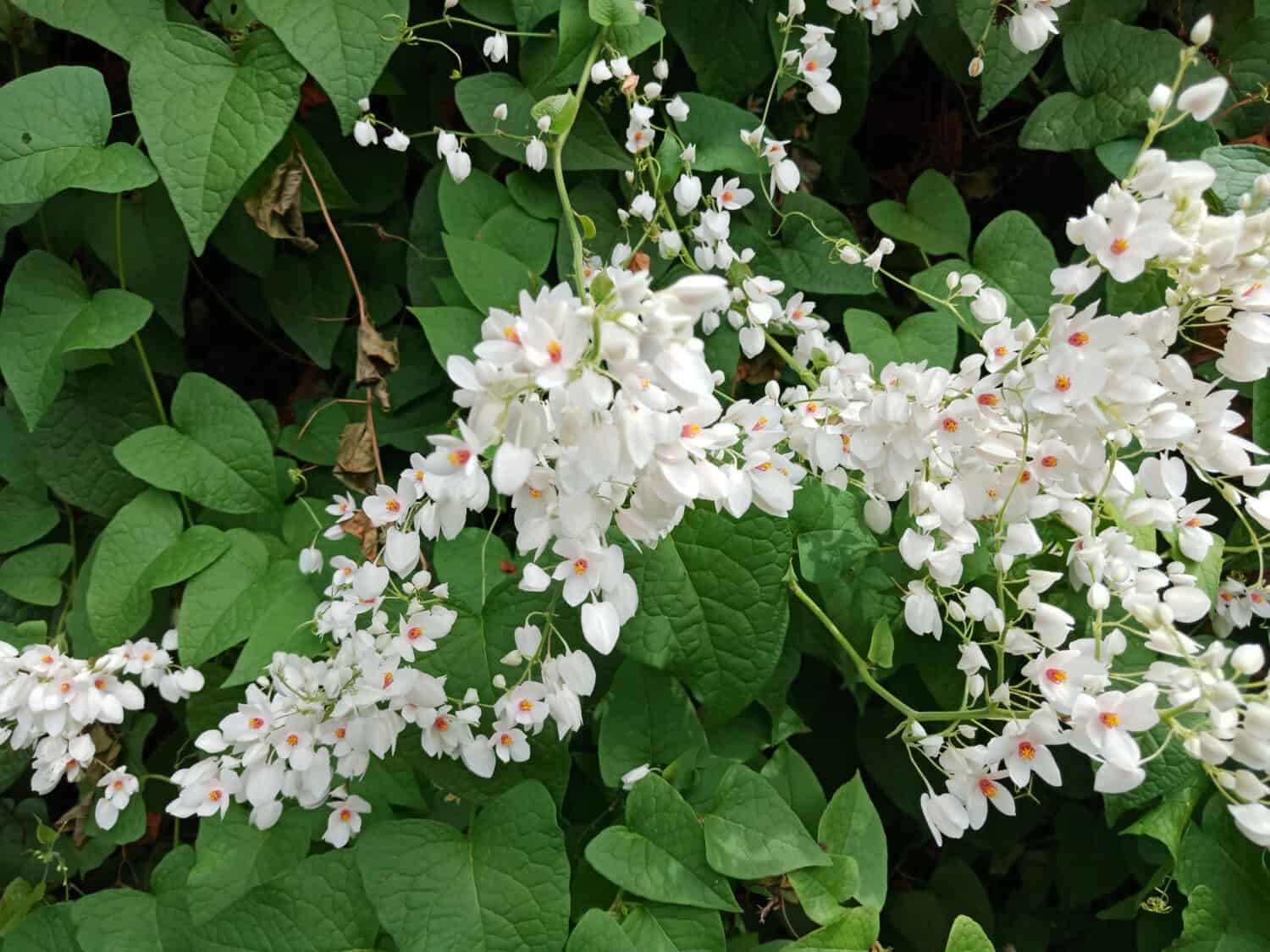
Paraphrased:
The white sky vine is a vibrant and captivating vine that originates from Mexico. Its scientific name, Thunbergia grandiflora ‘Alba’, is also known as the white Bengal clock vine. This breathtaking vine remains green throughout the year and features thick, dark leaves and long, twining stems. Not only are its flowers white, but they also display a striking yellow-striped center. These enchanting blooms can be seen from mid-summer until late fall and measure approximately 3 inches in width. It’s worth noting that white sky vines prefer warmer climates and are ideally grown in USDA growing zones 8a to 11b. To maximize growth and save space, it is recommended to plant this vine near a trellis or fence.
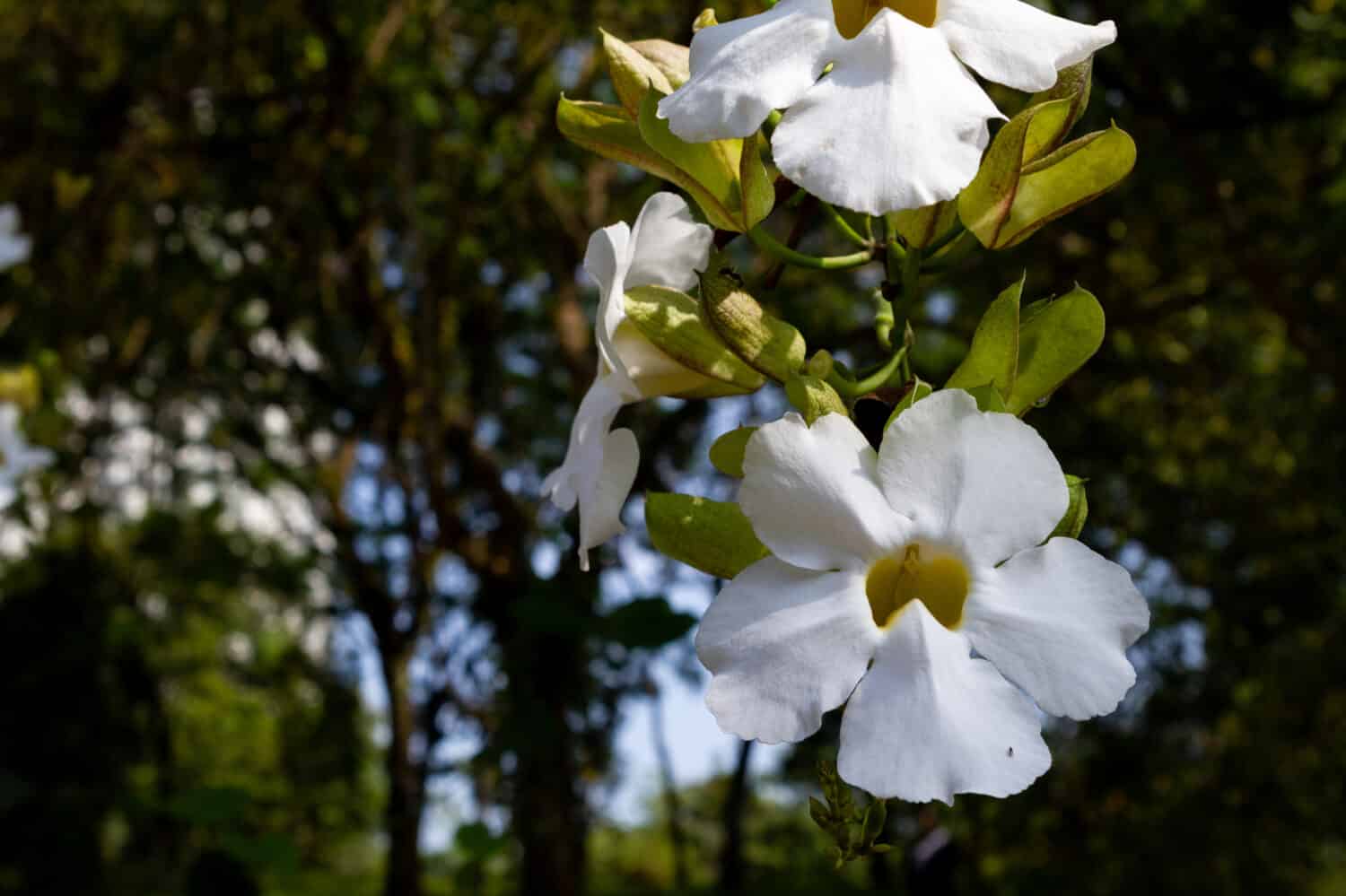
1. White sky vines are known for their stunning white flowers that feature yellow-striped centers.
2. Snail vine, a member of the Fabaceae family, is included in this list despite not being entirely white.
3. Also known as corkscrew vine, snail vines have distinct, fragrant flowers in the shape of snail shells or corkscrews.
4. Native to Central and South America, snail vines can be annuals or perennials depending on their environment.
5. During the summer, snail vines produce clusters of small, fragrant flowers in vibrant shades of pink, purple, and white.
6. If these flowers are successfully pollinated, they develop seedpods, allowing you to easily propagate multiple snail vines by drying the seeds.
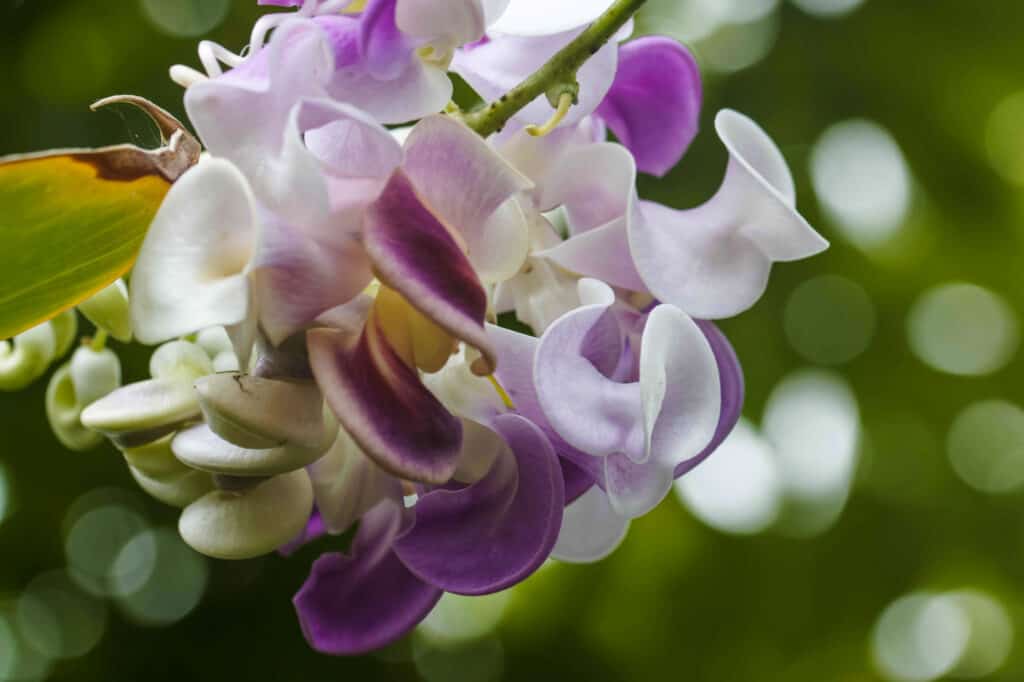
The pink, purple, and white flowers of the snail vine are a sight to behold. With their unique shape resembling snails, these flowers add a touch of whimsy to any garden. Graeme L Scott captures the beauty of these flowers in his photograph.
Now, let’s talk about the seventh plant on our list – the white mandevilla vine. While mandevilla plants can come in various colors, we’re specifically focusing on the white ones. These vines were officially identified in 1840 and are often referred to as rock trumpets. Originating from parts of North and South America, particularly the Serra dos Órgãos forests in Rio de Janeiro, Brazil, these vines are known for their lush climbing abilities.
If you’re looking for a climbing vine that boasts large, fragrant flowers, then the white mandevilla vine is a perfect choice. Its vibrant blooms make for a stunning display when grown along a trellis or fence. So, if you’re in search of a beautiful and fragrant addition to your garden, look no further than the white mandevilla vine.

Mandevilla vines possess an extensive variety, with a delightful array of colors and a pleasant fragrance. Moving onto the next plant, we have the climbing white jasmine. This particular jasmine, also known as the true or common jasmine, belongs to the olive family and goes by the scientific name Jasminum officinale. Although it originates from certain parts of Asia and the Caucasus, it has managed to naturalize itself globally.
Climbing white jasmines have gained popularity as garden flowers. During the summer season, these plants showcase their beauty with the blooming of numerous small white flowers, sometimes numbering in the thousands. Gardeners particularly appreciate this plant for its abundant and delicate flowers, which also emit a delightful fragrance. In fact, the scent of jasmine is commonly used in aromatherapy and is a well-known aroma in sweet and heavy perfumes.
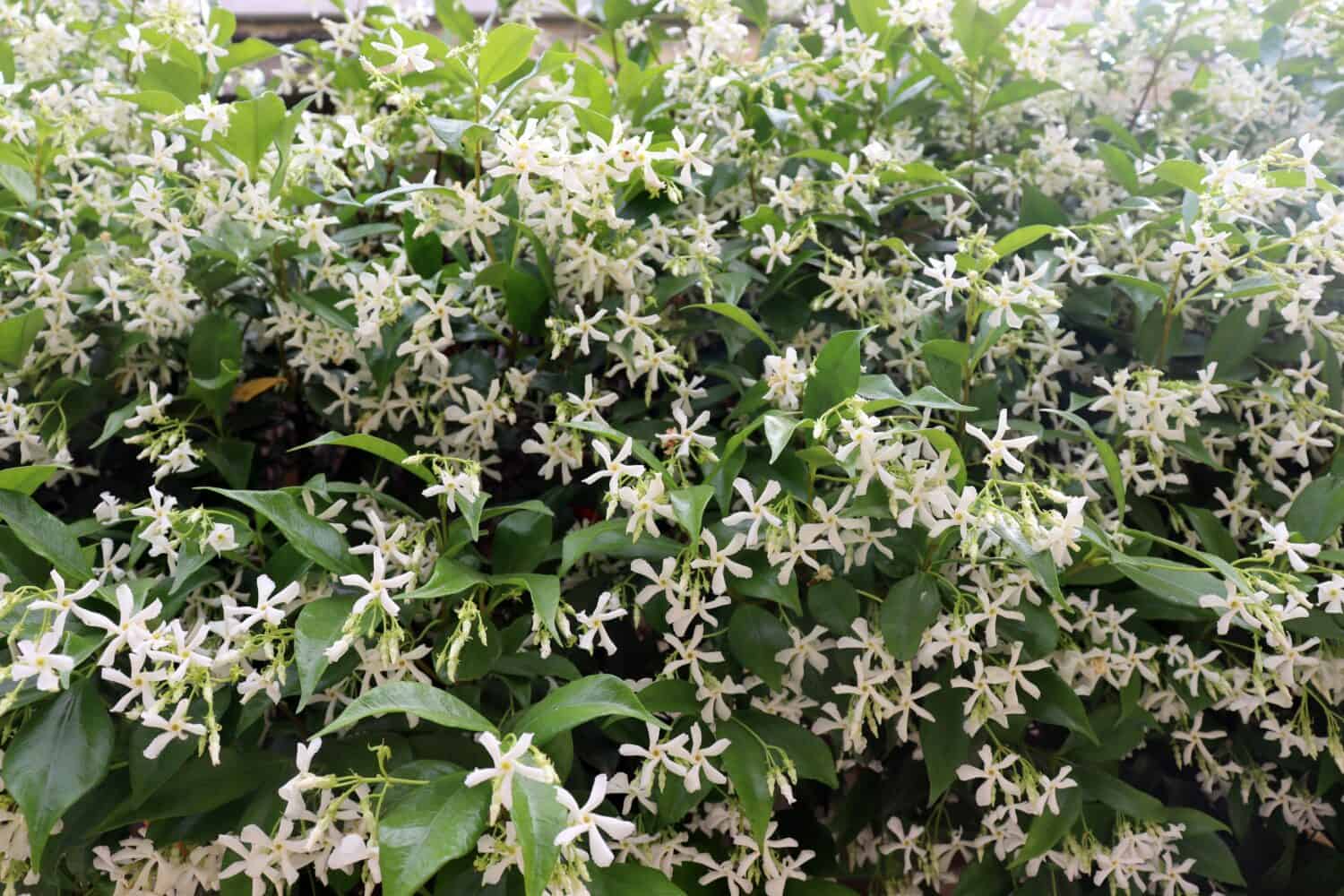
Climbing white jasmines are widely known and highly sought-after flowers in gardens. However, another stunning vine that deserves recognition is the white flowering honeysuckle vine, also known as the western white honeysuckle. Its scientific name is Lonicera albiflora. This vine is naturally found in certain regions of the southeastern United States, including Oklahoma, Arizona, New Mexico, and Texas. It has the ability to grow as either a small leafy vine or a shrub, with a maximum height of approximately 4 feet. In some cases, the vine can reach heights of up to 10 feet. The flowers of the white flowering honeysuckle vine grow in clusters measuring about 2 inches in size and bloom during the spring months, specifically from March to May.
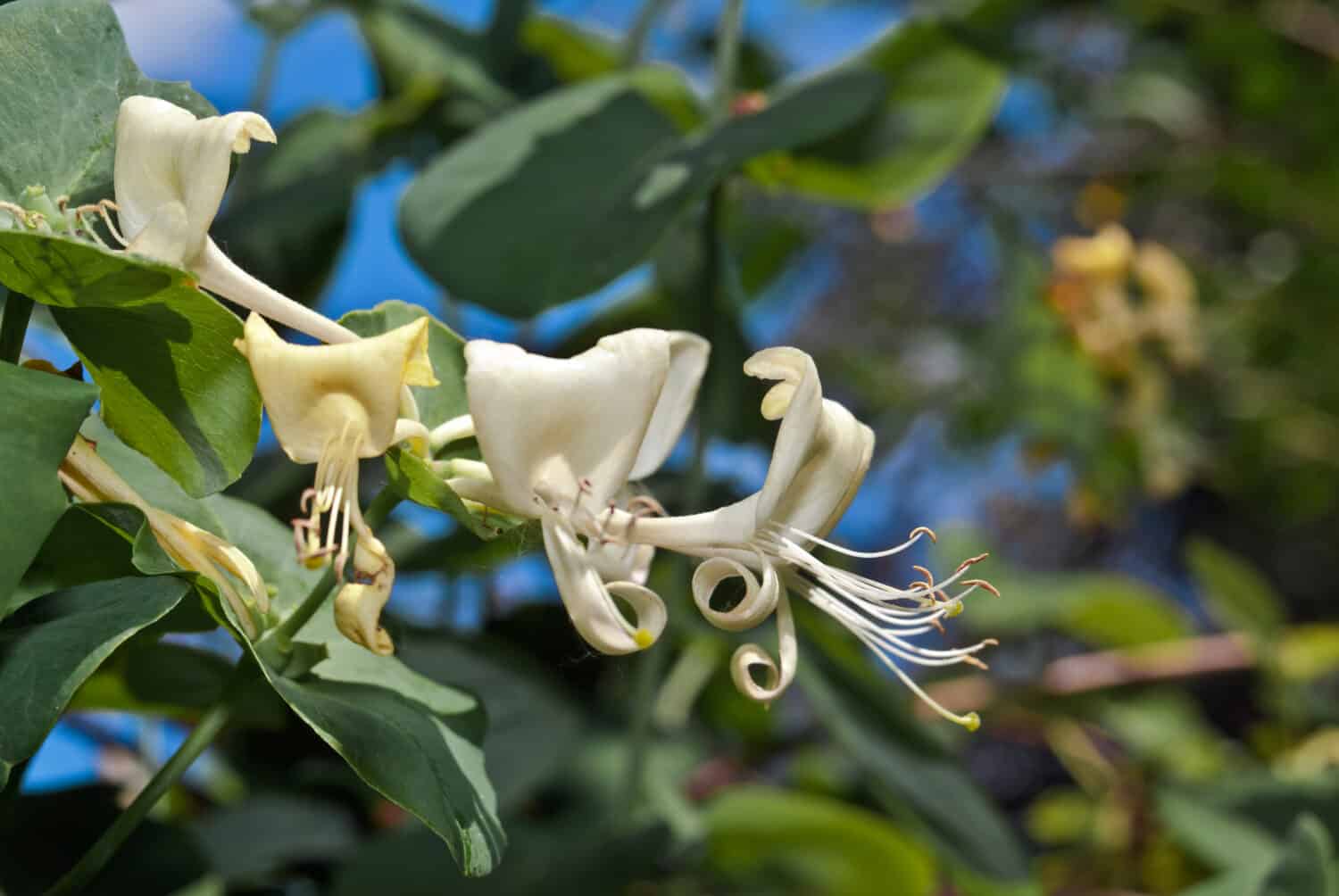
Did you ever come across the magnificent bleeding heart vine? This extraordinary flowering plant belongs to the Lamiaceae family and goes by the scientific name Clerodendrum thomsoniae. Originally from tropical west Africa, specifically from Cameroon to Senegal, this vine is truly a sight to behold. Its foliage consists of luscious dark green ovate to oblong leaves, spanning around 7 inches in length. The flowers of this vine form in clusters, showcasing a combination of white and light pink hues with a red five-lobed corolla. People widely appreciate bleeding heart vines for their decorative purposes, often finding them in charming gardens across warm southern regions. However, it’s important to note that these delicate plants are not suited for frosty conditions.
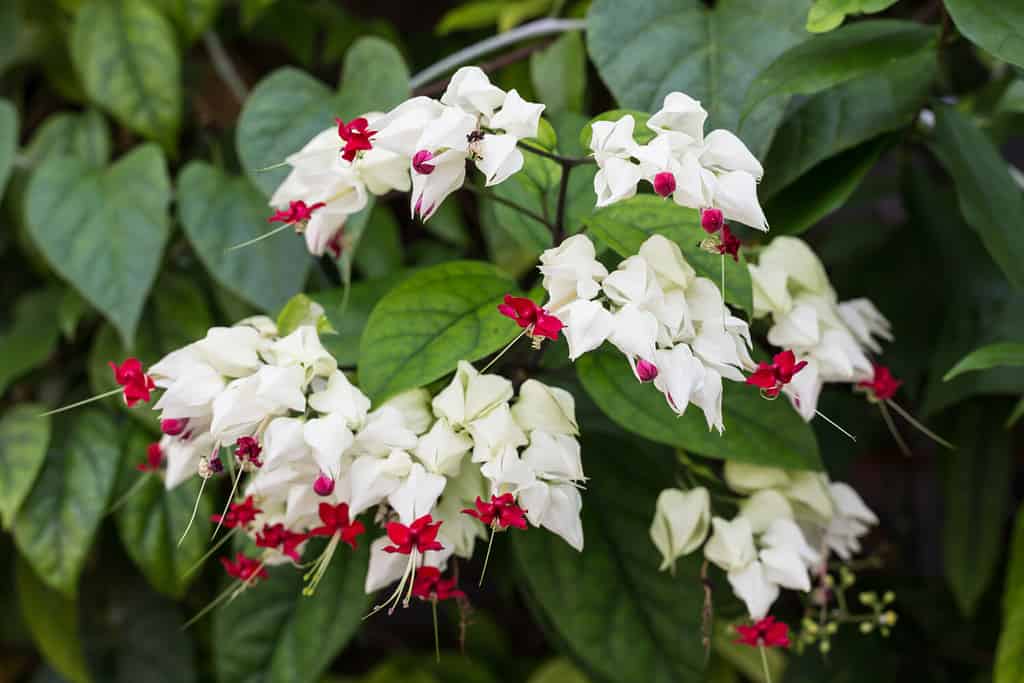
There are various names for bleeding heart vines, one of which is bagflowers. These plants are also known as wild cucumbers, scientifically called Echinocystis lobata. They are native to North America and can be found in 40 states within the United States, except for most of the southeastern region. Wild cucumbers are beautiful sprawling vines that can grow up to 26 feet in length. They are great climbers and are often grown on trellises. However, despite their appealing appearance, the fruits of wild cucumbers are not suitable for consumption.
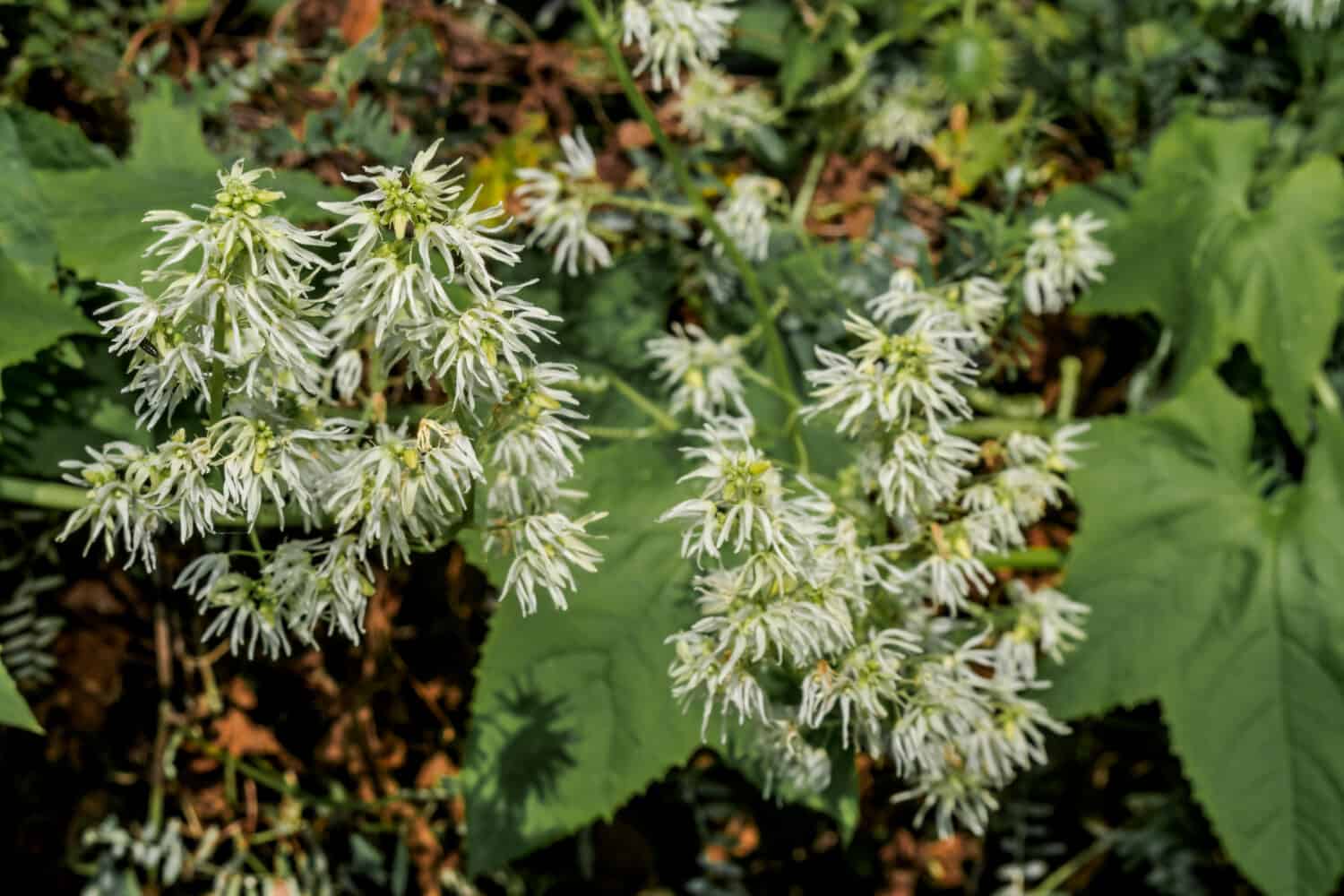
White bougainvillea is the twelfth vine on our list of vines that produce beautiful white flowers. While not all bougainvillea flowers are white, they can also be pink, yellow, red, or purple. These thorny ornamental vines have the ability to grow as shrubs and there are between 4 to 22 species of vines within the bougainvillea genus, along with numerous cultivars. The height of these plants can range anywhere from 3 to 39 feet, and they can be grown both in the ground and in containers. They are also suitable for hanging baskets. However, it’s important to note that white bougainvillea vines thrive best in warmer climates, specifically in USDA growing zones 9b and 10.
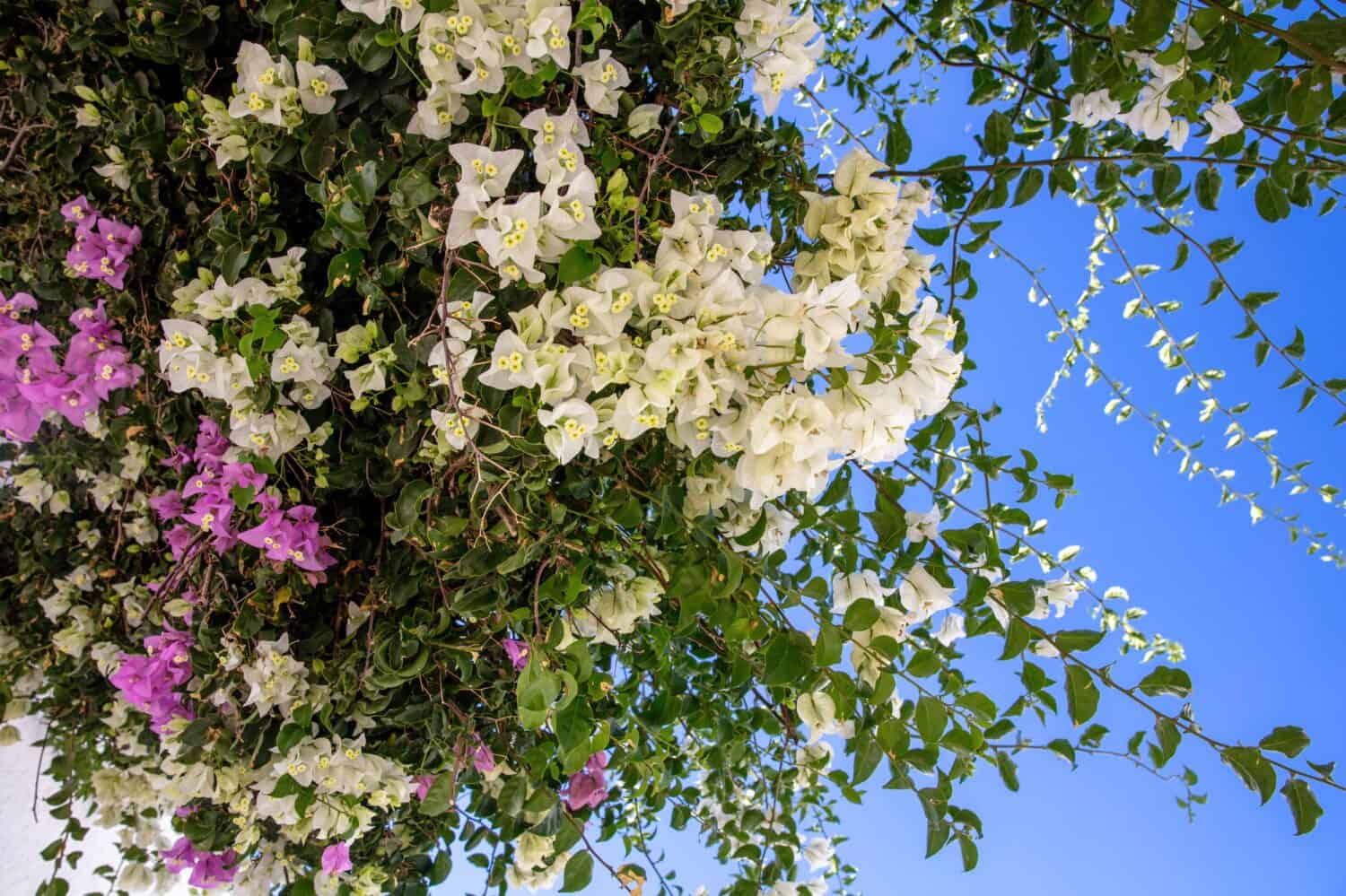
One of the flowers that you are likely to come across quite often is the white morning glory. This beautiful flower is a part of a large family that boasts thousands of species, each varying in size and color. Known for its long vines and stunning blooms, the morning glory can reach up to 10 feet in length, adding a touch of elegance to any space. Another remarkable feature of these flowers is their resilience, as they can thrive in various climates, ranging from USDA growing zones 2-11. Furthermore, morning glory vines are quite versatile, and you can easily grow them in containers if you have limited space.
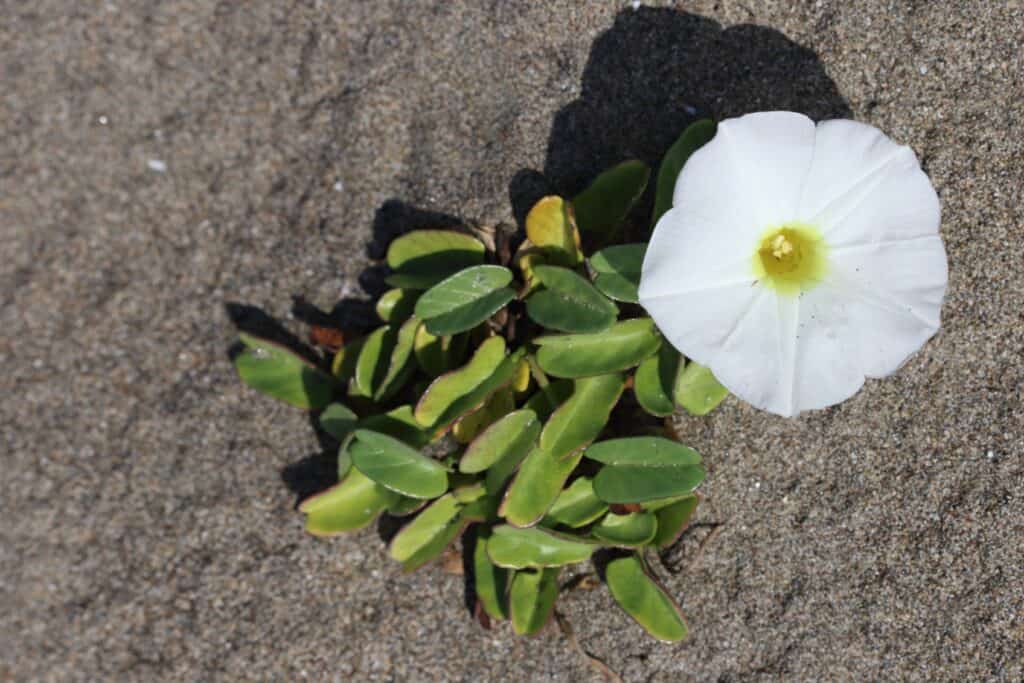
There are numerous options when it comes to morning glory species. One captivating choice is the White Japanese Wisteria, a stunning plant that hangs gracefully. Native to Korea and Japan, this twining vine produces long branches adorned with beautiful white flowers. The fragrance of these flowers fills the air as they bloom abundantly during the spring season. If you decide to cultivate this plant, it is important to note that while it can be initially started in a container, it will require ample space to grow. It is advisable to transplant it near a sturdy structure that can provide the necessary support, considering its weight. With optimal conditions, the White Japanese Wisteria can grow up to an impressive height of 30 feet and spread as wide as 20 feet, creating a whimsical and serene ambiance in your yard.
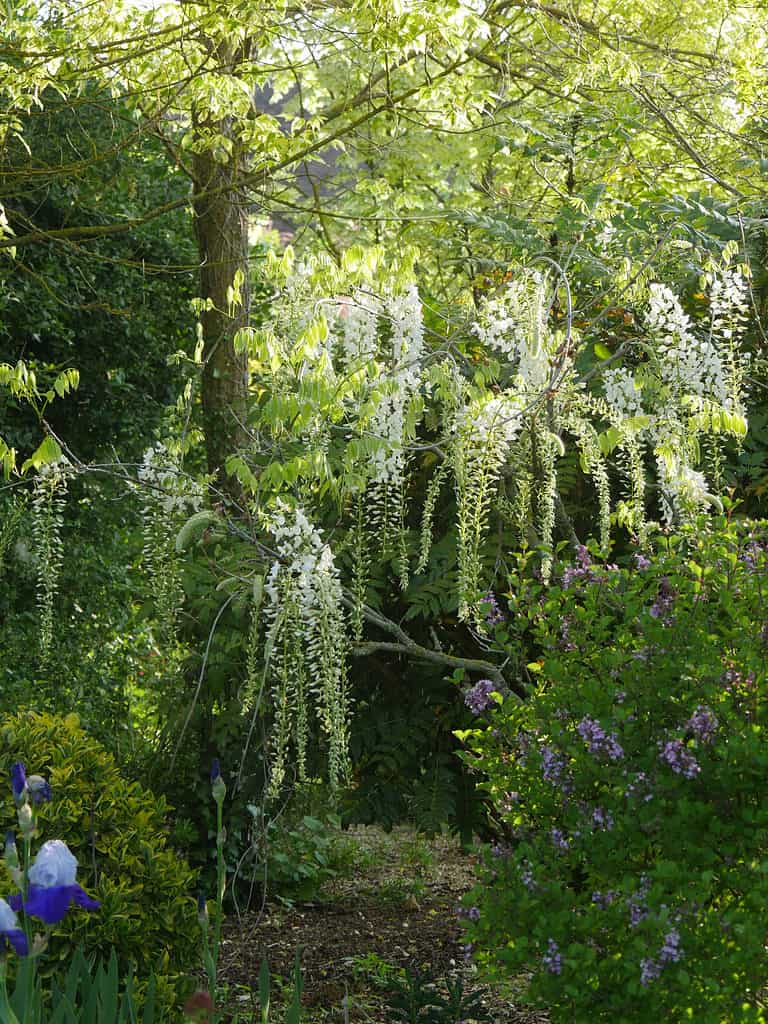
15. Elegant White Trailing Fuchsia Vines
The breathtaking white trailing fuchsia vines capture attention effortlessly. These vines, which can also transform into shrubs or dwarf trees, possess an undeniable allure. Belonging to the Onagraceae family, they are fuchsias that enchant garden enthusiasts across North America as decorative plants. While their origin lies in the southern regions of Peru, Bolivia, and northern Argentina, their beauty has found popularity in diverse corners of the world. Although the flowers of these captivating vines are not completely white, their delicate hues encompass shades of pink, white, and yellow-green. With their slender, tubular form, these stunning blossoms grow in clusters, further enhancing their appeal.
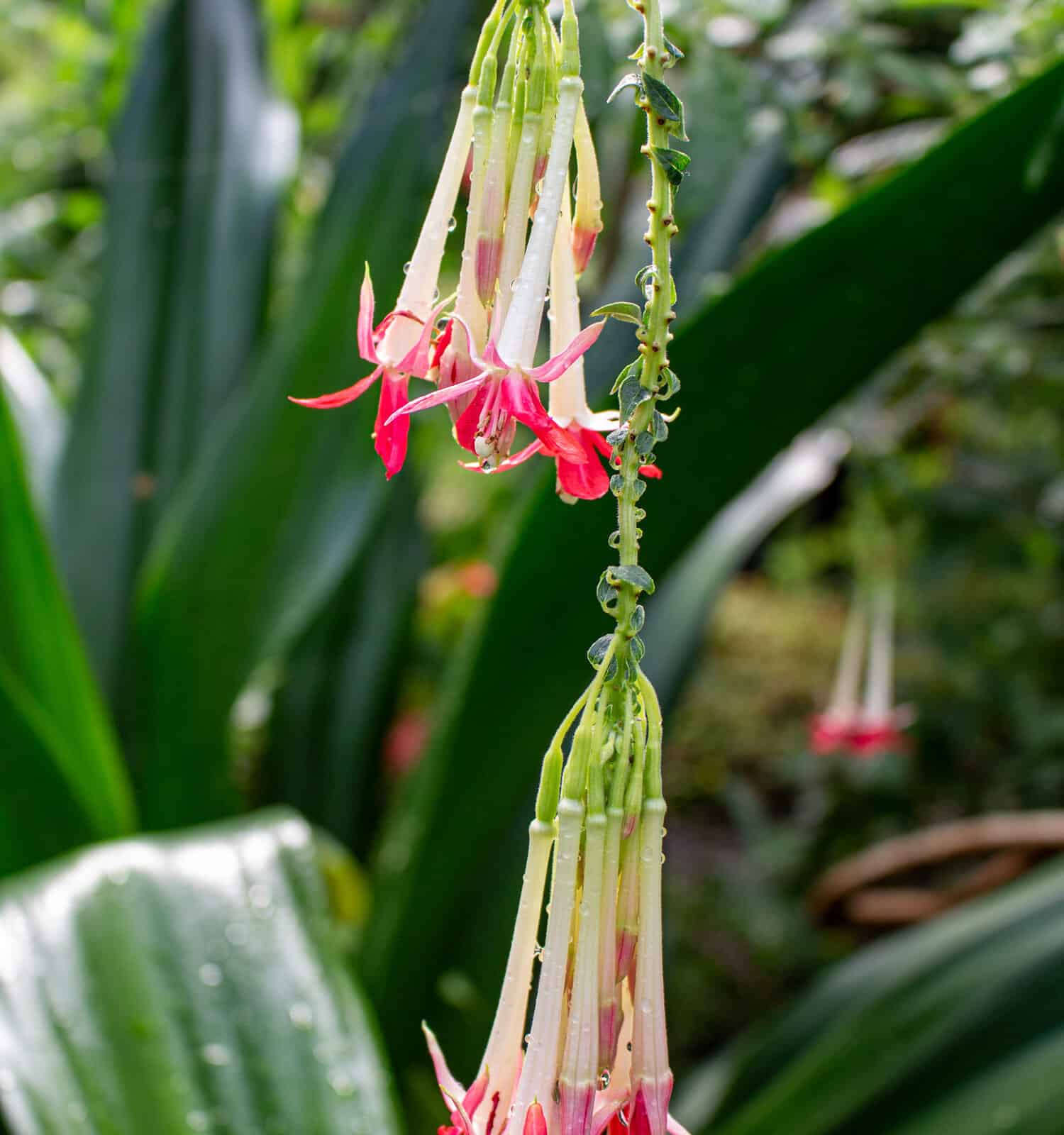
The white trailing fuchsia vines have the remarkable ability to grow either as shrubs or small trees. This unique and versatile vine is joined by another stunning white-flowering option: the white flowering clematis. Also known as the leatherflower, the clematis is a genus within the Ranunculaceae family, encompassing various species with different sizes, fragrances, and colors of flowers. Some of these beautiful flowers are bright white, exuding elegance and a sweet scent, while others are larger and slender, showcasing a striking red hue. One popular white flowering clematis is the Clematis ligusticifolia, commonly known as Old-man’s Beard.
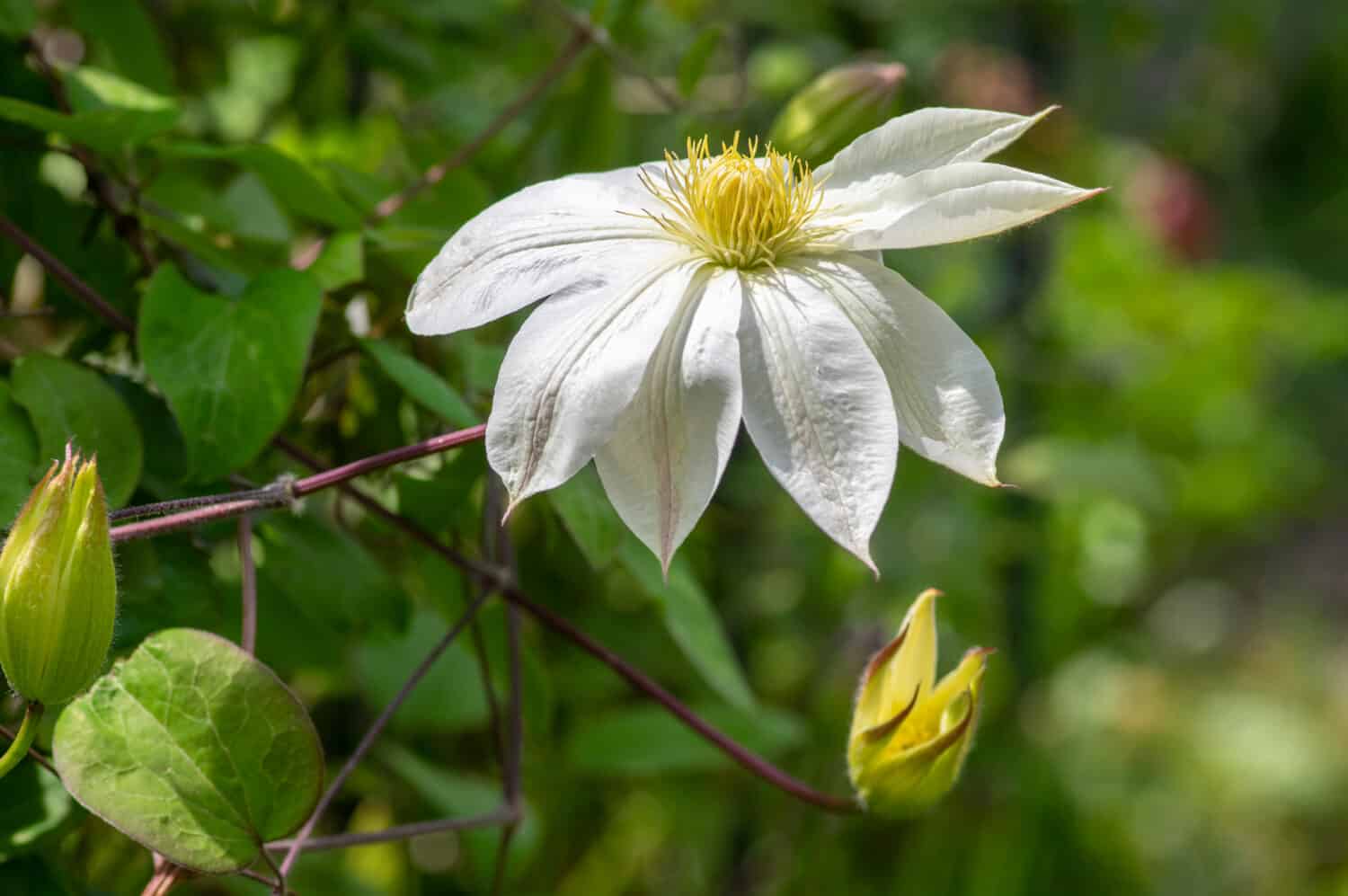
The charming sweet pea is a delightful vine that originates from Sicily, southern Italy, and the Aegean Islands. Its scientific name is Lathyrus odoratus. These vines are annual and have rapid growth, reaching heights of up to 6 feet and 7 inches. The sweet pea flowers come in a wide array of colors, ranging from bi-colored varieties to solid red, purple, pink, or blue. While these vibrant flowers are truly stunning, they are susceptible to various diseases and pests, including troublesome aphids. If you notice yellowing and wilting leaves on your sweet pea plants, it may be a sign of an aphid infestation.
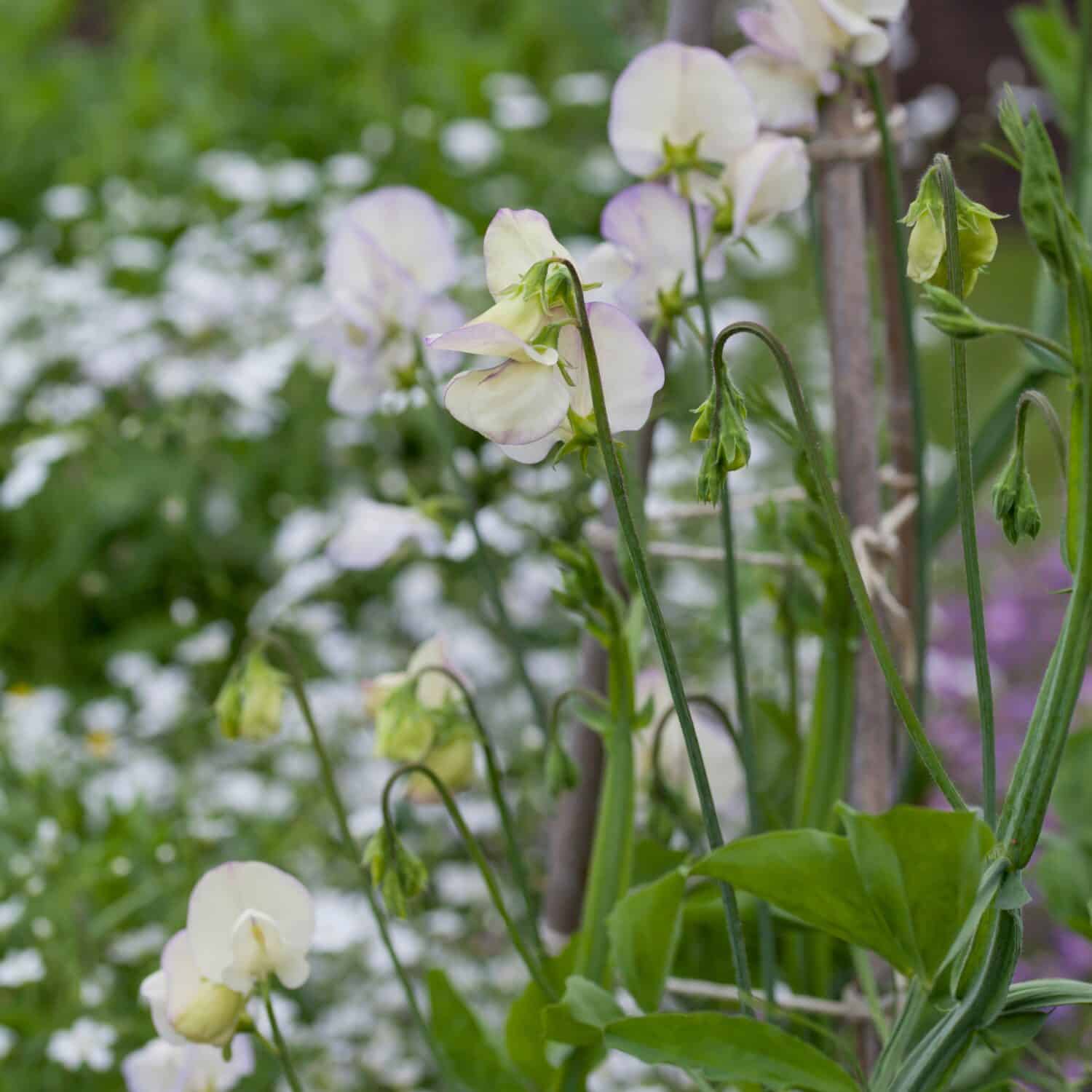
18. Enigmatic Blossoms: The Marvelous Moonflower
The moonflower, a captivating and extraordinary plant, captivates with its enchanting name. This mystical flower originates from the tropical and subtropical regions of North and South America, known for its alluring charm. Often referred to as tropical white morning glories, moonflowers are perennial climbing vines that reach astonishing heights of up to 98 feet. Adorned with luminous white petals and adorned with dark green, heart-shaped leaves, these plants showcase their remarkable beauty. The leaves themselves measure approximately 2 to 5.9 inches in length, adding to the allure of the moonflower.
What makes this flora truly intriguing is its blooming behavior. Moonflowers unfold their resplendent blossoms during the nighttime hours, only to gently close as the sun peeks over the horizon, often embellishing them with the first trace of morning dew. This captivating trait is undoubtedly the inspiration behind their evocative name, evoking a sense of magic and mystery in the minds of those who encounter these ethereal blooms.

Moonflowers are known for blooming at night and in cooler weather, while the white Madagascar jasmine, scientifically known as Stephanotis floribunda, is another jasmine plant that deserves attention. This particular flowering vine is actually native to the beautiful island of Madagascar. With long and winding wooden branches, it showcases stunning white waxy star-shaped flowers that emit a strong fragrance. Summer is the season when these lovely blossoms bloom. Interestingly, the plant has the potential to grow up to an impressive height of 20 feet.

The Madagascar jasmine flowers, which can grow up to a staggering height of 20 feet, are indigenous to Madagascar. This particular type of flower is known for its elegant white petals that resemble butterflies. Another pea plant that displays beautiful white flowers is the white butterfly pea. This unique plant is native to the island of Ternate in Indonesia but can also be found in both Africa and Australia. It is a popular choice for adding a touch of beauty to spring gardens. The white butterfly pea is also known as the Asian pigeonwing and the blue pea. Belonging to the Fabaceae family, these peas come in various colors, including deep violet ones with white centers and pink and white variations. Not only are these plants visually appealing, but they are also quite resilient and rarely succumb to diseases or ailments.

The white butterfly pea is also known as the Asian pigeonwing. It is a beautiful vine that produces small and delicate white flowers. One specific variety of bean that is known for its white flowers is the runner bean called ‘White Lady’. This vine is also referred to as the scarlet runner bean and butter bean, although lima beans share the same nickname. White lady runner beans can be grown for both their ornamental beauty and as a source of food. The edible beans can be found inside the seed pods. These beans have been cultivated for centuries, dating back to around 2000 BC. While runner beans are commonly associated with red flowers and beans, not all varieties exhibit this color.
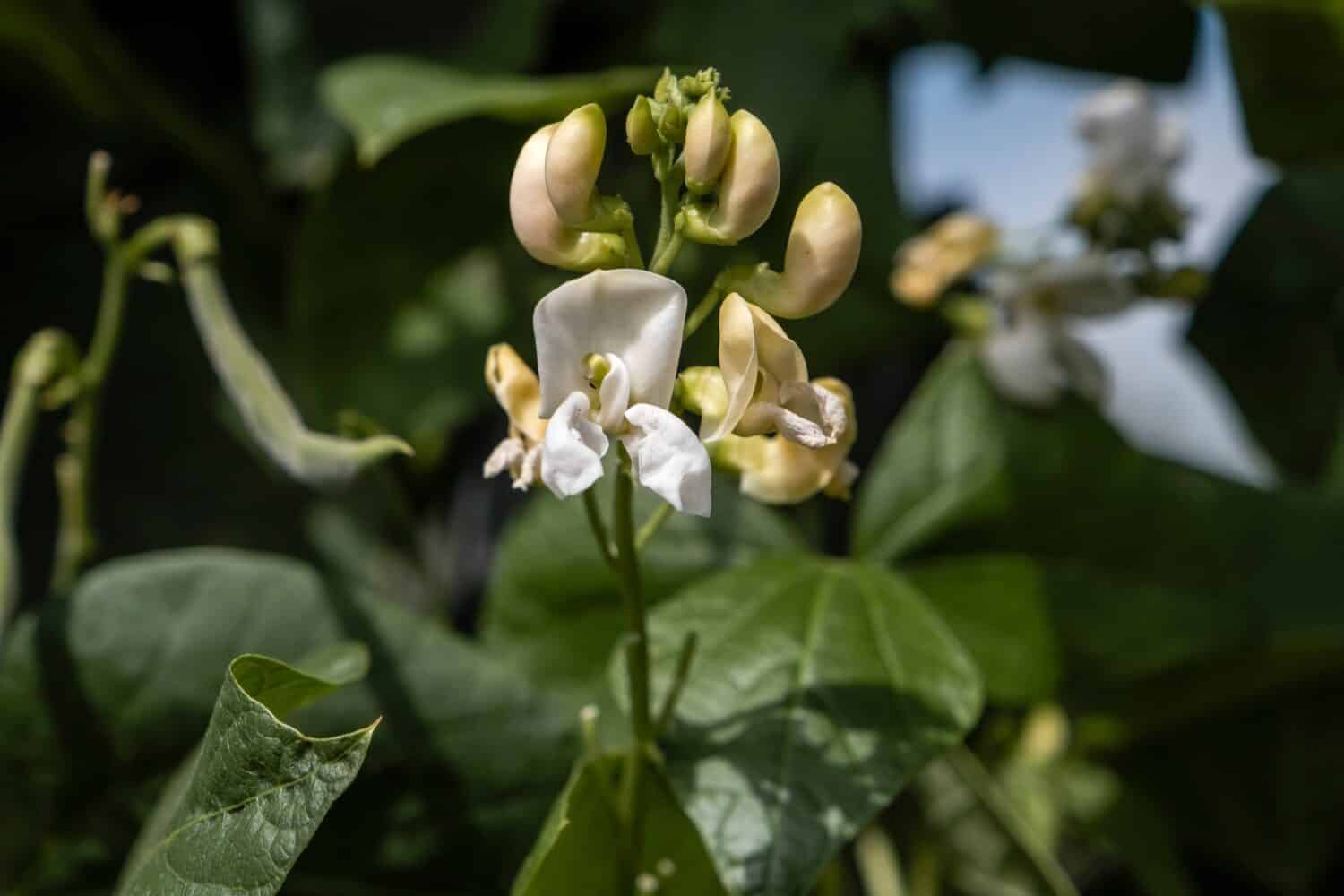
Runner beans have multiple names, including butter beans, although they should not be mistaken for lima beans. Additionally, the white passion fruit flower vine is another noteworthy plant. These passion fruit plants are vigorous vines that grow rapidly, and each species and cultivar has its own distinct flower. The white passion fruit flower, although predominantly white, is not entirely so. Its beautiful and aromatic star-like blooms also have touches of purple and pink. These flowers eventually give rise to small and tangy yellow-green fruits.

White passion flowers yield petite yellow-green fruit. It’s important to note that not all passion flowers exhibit a white hue. The captivating image showcased above is brought to you by the talented Sanchita Visual Arts.